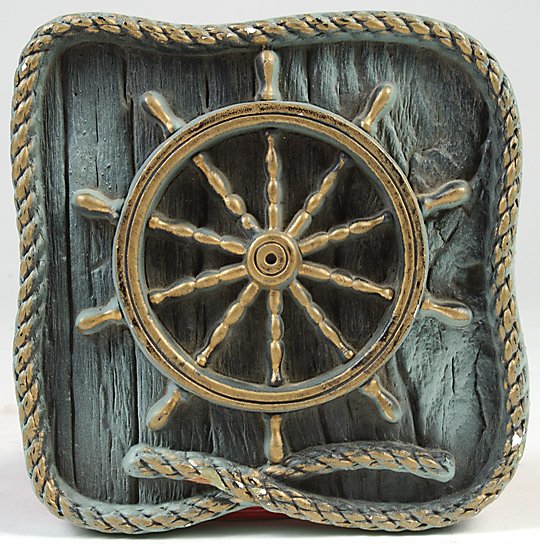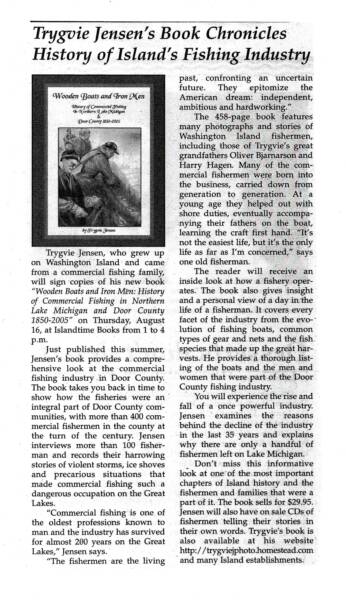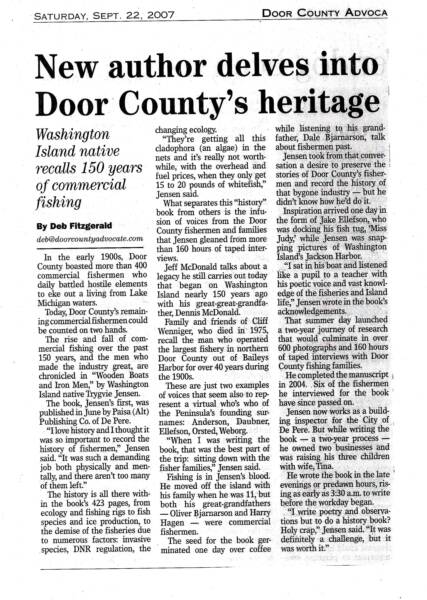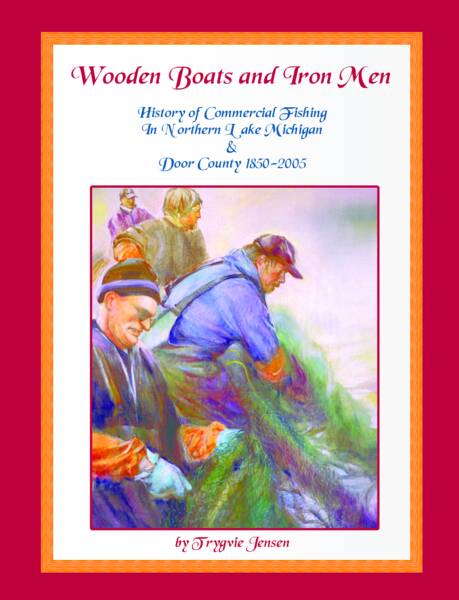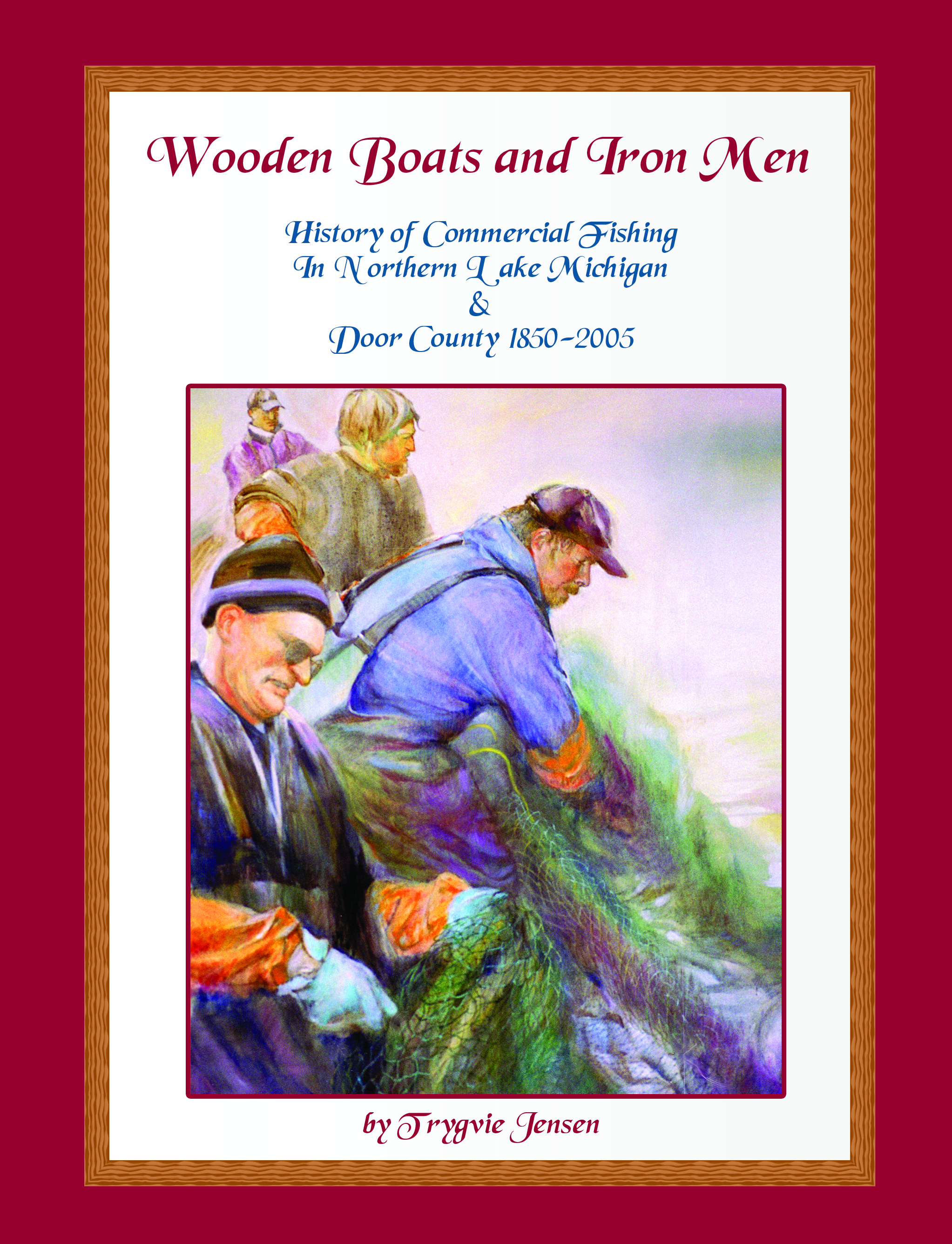Arts and Literature
A Review – Wooden Boats and Iron Men
Wooden Boats and Iron Men: History of Commercial Fishing
in Northern Lake Michigan and Door County 1850-2005
By Trygvie Jensen
By Charlie Calkins
The potential for commercial fishing was the magnet drawing many early permanent settlers to the Door County area. Ever since, the Door County commercial fishery has remained very important. Trygvie Jensen, a Washington Island native, has provided a comprehensive history of this significant local industry. His book Wooden Boats and Iron Men: History of Commercial Fishing in Northern Lake Michigan and Door County 1850-2005 details in a most informative and understandable way the long, proud history of this dangerous but rewarding economic activity.
Most of us are generally familiar with the end product of commercial fishing – the fish. Who has not had a tasty whitefish dinner, for example. However, how many of us have even the slightest inkling about the process that produced that meal. Not to worry. Jensen provides us with the specifics necessary for a good understanding of the basics of this complicated activity.
Jensen divides his book into three related parts. Part I is “A General History of Commercial Fishing in Lake Michigan.” After a chapter devoted to an historical overview of the rise of commercial fishing in his study, Jensen turns his attention to those basics of fishing. In successive chapters he treats the fishing rigs, the commercial fish species, and ice production. These subjects are treated by relying on wide-ranging pertinent primary and secondary sources. These are complimented by informative quotes drawn from extensive personal interviews with those on the front lines – the commercial fishermen themselves. This is the case throughout the entire book. The author has a firm command of his subject and uses information provided from interviews to undergird his case.
The first section then brings together the information provided in the preceding pages by treating the day-to-day activities of a fisherman. Then he becomes a bit more philosophical in his approach by addressing fishing stories that are far different than those that lament “the one that got away.” These have meaning. They relate the trials and tribulations of attempting to earn one’s living from fishing. Again Jensen relies heavily on information provided by the fishermen themselves. This section concludes with an examination of fishermen’s attitudes, reflections, and observations. For my money, this is perhaps the most enlightening and meaningful section of the book. It could have been titled “The Soul of a Commercial Fisherman.”
Part II focuses on the long and storied history of the Washington Island fishery. Jensen shines here. Every nook and cranny of his native island fishery is detailed. The sound basics of a journalism course are revealed by the author. The who, what, when, where, and why are covered with interesting fact, anecdote, and supposition. This is not only a history of fishing on the island, it is a virtual island genealogy of fishermen. This kind of detail impressed this reviewer. It is based on solid research. It is evident that the author paid his dues in doing the research necessary for writing an informed book.
Part III turns our attention to the commercial fishing industry of a slightly different locale – northern Door County. In order, Jensen treats the same topics for the northern Door settlements of Gills Rock, Ellison Bay, Sister Bay, Ephraim, Fish Creek, etc. The detail we have been accustomed to earlier in the book is continued here. Attention to detail is a hallmark. As I read this book, I continued to be impressed by the attention to specifics, all supported by appropriate footnoting.
Potential readers should not be put off by what might appear, at first glance, to be a lengthy book about a seemingly narrow topic. Jensen’s book is not intended solely for those interested in the many different facets of fishing. Here is a work that should speak to anyone with a broad interest in the many diverse aspects of the history of Door County. We do not need more general histories of this area. Instead, we need more good books, like this one, that treat in significant and meaningful detail an important aspect of the overall general history of Door County. In this regard, Wooden Boats and Iron Men compliments another recent addition to the local bookshelf, Bill Tischler’s Door County’s Emerald Treasure, a thorough history of Peninsula State Park.
Books like these are most welcome. Authors interested in writing about Door County would be well advised to follow these models in treating other topics that make up the complex history of this area. It will take an extra effort, however to match the richness of specifics and overall completeness provided by Jensen about his subject.
Charlie Calkins is a retired geography professor, a part-time Door County resident, and an inveterate collector of printed material related to the county. In his spare time he operates the Badger Bibliophile, a business specializing in buying and selling gently used Wisconsin books and maps. His wares are sold at several antique malls in the state, including the Peninsula Antique Center in Egg Harbor. E-mail him at wibooks@milwpc.com.
Related to this article...


